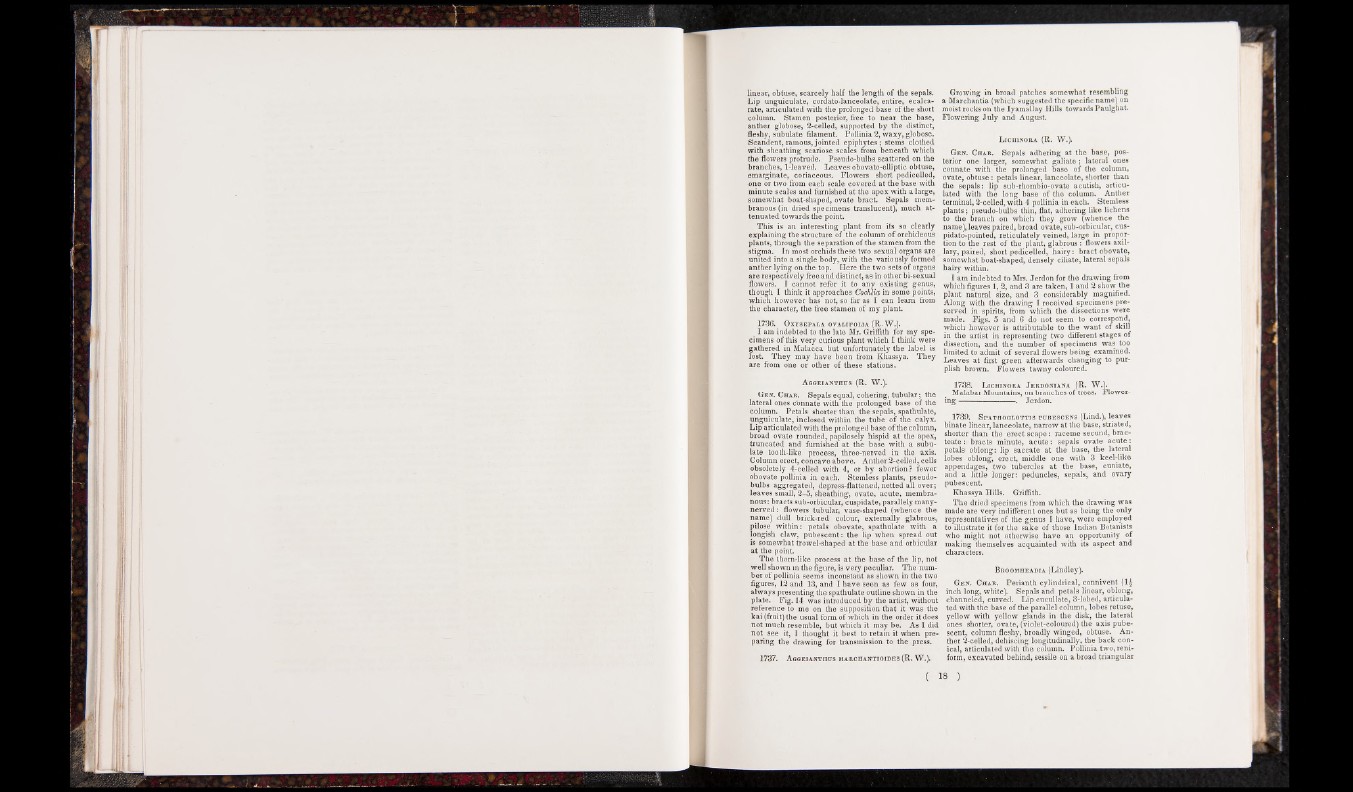
linear, obtuse, scarcely half the length of the sepals.
Lip unguiculate, cordato-lanceolate, entire, ecalca-
rate, articulated with the prolonged base of the short
column. Stamen posterior, free to near the base,
anther globose, 2-celled, supported by the distinct,
fleshy, subulate filament. Pollinia 2, waxy, globose.
Scandent, ramous, jointed epiphytes; stems clothed
with sheathing scariose scales from beneath which
the flowers protrude. Pseudo-bulbs scattered on the
branches, 1-leaved. Leaves obovato-elliptic obtuse,
emarginate, coriaceous. Flowers short pedicelled,
one or two from each scale covered at the base with
minute scales and furnished at the apex with a large,
somewhat boat-shaped, ovate bract. Sepals membranous
(in dried specimens translucent), much attenuated
towards the point.
This is an interesting plant from its so clearly
explaining the structure of the column of orchideous
plants, through the separation of the stamen from the
stigma. In most orchids these two sexual organs are
united into a single body, with the variously formed
anther lying on the top. Here the two sets of organs
are respectively free and distinct, as in other bi-sexual
flowers. I cannot refer it to any existing genus,
though I think it approaches CocMia in some points,
which however has not, so far as I can learn from
the character, the free stamen of my plant.
1736. OXYSEPALA OVALIFOLIA (R. W.).
I am indebted to the late Mr. Griffith for my specimens
of this very curious plant which I think were
gathered in Malacca but unfortunately the label is
lost. They may have been from Khassya. They
are from one or other of these stations.
Aggeianthus (R. W.).
Gen. Char. Sepals equal, cohering, tubular; the
lateral ones c'onnate with the prolonged base of the
column. Petals shorter than the sepals, spathulate,
unguiculate, inclosed within the tube of thé calyx.
Lip articulated with the prolonged base of the column,
broad ovate rounded, papilosely hispid at the apex,
truncated and furnished at the base with a subulate
tooth-like process, three-nerved in the axis.
Column erect, concave above. Anther 2-celled, cells
obsoletely 4-celled with 4, or by abortion? fewer
obovate pollinia in each. Stemless plants, pseudobulbs
aggregated, depress-flattened,netted all over;
leaves small, 2-5, sheathing, ovate, acute, membranous:
bracts sub-orbicular, cuspidate, parallely many-
nerved: flowers tubular, vase-shaped (whence the
name) dull brick-red colour, externally glabrous,
pilose within: petals obovate, spathulate with a
longish claw, pubescent: the lip when spread out
is somewhat trowel-shaped at the base and orbicular
at the point.
The thorn-like process at the base of the lip, not
well shown m the figure, is very peculiar. The number
of pollinia seems inconstant as shown in the two
figures, 12 and 13, and I have seen as few as four,
always presenting the spathulate outline shown in the
plate. Fig. 14 was introduced by the artist, without
reference to me on the supposition that it was the
kai (fruit) the usual form of which in the order it does
not much resemble, but which it may be. As I did
not see it, I thought it best to retain it when preparing
the drawing for transmission to the press.
1737. Aggeianthus marchantioibes (R. W.).
Growing in broad patches somewhat resembling
a Marchantia (which suggested the specific name) on
moist rocks on the Iyamallay Hills towards Paulghat.
Flowering July and August.
Lichinora (R. W.).
Gen. Char. Sepals adhering at the base, posterior
one larger, somewhat galiate; lateral ones
connate with the prolonged base of the column,
ovate, obtuse: petals linear, lanceolate, shorter than
the sepals: lip sub-rhombio-ovate acutish, articulated
with the long base of the column. Anther
terminal, 2-celled, with 4 pollinia in each. Stemless
plants; pseudo-bulbs thin, flat, adhering like lichens
to the branch on which they grow (whence the
name), leaves paired, broad ovate, sub-orbicular, cus-
pidato-pointed, reticulately veined, large in proportion
to the rest of the plant, glabrous: flowers axillary,
paired, short pedicelled, hairy: bract obovate,
somewhat boat-shaped, densely ciliate, lateral sepals
hairy within.
I am indebted to Mrs. Jerdon for the drawing from
which figures 1, 2, and 3 are taken, 1 and 2 show the
plant natural size, and 3 considerably magnified.
Along with the drawing I received specimens preserved
in spirits, from which the dissections were
made. Figs. 5 and 6 do not seem to correspond,
which however is attributable to the want of skill
in the artist in representing two different stages of
dissection, and the number of specimens was too
limited to admit of several flowers being examined.
Leaves at first green afterwards changing to purplish
brown. Flowers tawny coloured.
1738. Lichinora Jerdoniana (R. W.).
Malabar Mountains, on branches of trees. Flowering
--------------------- . Jerdon.
1739. Spathoglottis pubescens (Lind.), leaves
binate linear, lanceolate, narrow at the base, striated,
shorter than the erect scape: raceme secund, brac-
te a te : bracts minute, a c u te : sepals ovate a c u te:
petals oblong: lip saccate at the base, the lateral
lobes oblong, erect, middle one with 3 keel-like
appendages, two tubercles at the base, cuniate,
and a little longer: peduncles, sepals, and ovary
pubescent.
Khassya Hills. Griffith.
The dried specimens from which the drawing was
made are very indifferent ones but as being the only
representatives of the genus I have, were employed
to illustrate it for the sake of those Indian Botanists
who might not otherwise have an opportunity of
making themselves acquainted with its aspect and
characters.
Broomheadia (Lindley).
Gen. Char. Perianth cylindrical, connivent (1£
inch long, white). Sepals and petals linear, oblong,
channeled, curved. Lip cucullate, 3-lobed, articulated
with the base of the parallel column, lobes retuse,
yellow with yellow glands in the disk, the lateral
ones shorter, ovate, (violet-coloured) the axis pubescent,
column fleshy, broadly winged, obtuse. Anther
2-celled, dehiscing longitudinally, the back conical,
articulated with the column. Pollinia two,reni-
form, excavated behind, sessile on a broad triangular